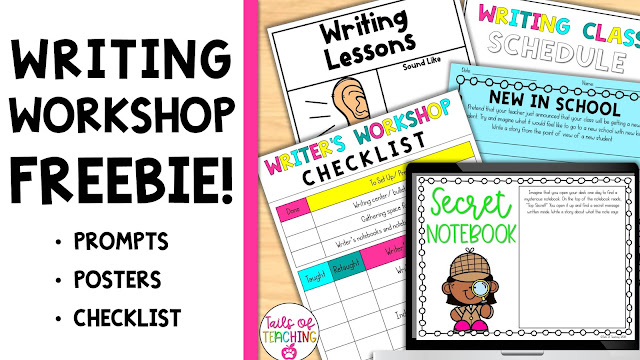What is the one sound that you do not want to hear during
your writers’ workshop? The sound of nothing. During a writers’ workshop, we
want to hear our students' pencils dashing back and forth to fill their pages
with their ideas. At writers’ workshop time we want to hear students flipping
another page to continue writing and sharing their thoughts on paper. What we
teachers do not want to hear during a writers’ workshop block, is the sound of
nothing. If no pencils are moving and no pages are flipping, then no writing is
happening. So why does this happen so often during our writers’ workshop
blocks? There are many reasons that students may not be writing at writing
time. From reluctant writers to good old fashion writer's block, there are many
reasons our students can struggle to put pencil to paper during writers’
workshops. However, these reasons can all be resolved with one teaching
strategy that saved my writers’ workshop many years ago, using graphic
organizers for writing. The year I started using graphic organizers for writing
was the year that everything changed in my writers’ workshop. Room 204 went
from a silent writers’ workshop to one filled with the sounds of scribbling
pencils and pages turning to add more ideas. Want to learn how I implemented
graphic organizers for writing with my students? Read more to learn my top
three reasons why graphic organizers for writing are the secret sauce to
writing block bliss!
The thinking in my school community during my first few years of teaching was that graphic organizers for writing were used only as a differentiation tool for below-benchmark students. This is a fine idea, however, I am in the camp of providing differentiation tools and support to all the learners in my classroom. So, I began using graphic organizers for writing in my writers’ workshop mini-lessons and independent practice times. The difference was amazing! Students at all benchmark levels were producing higher-quality writing pieces and moving through the writing process with more ease! Let’s explore why providing all students with graphic organizers for writing was and continues to be such a game changer. Want to learn more about setting up your best writers workshop ever? CLICK HERE to read my blog post now!
Tip #1 in my 3 Reasons Graphic Organizers for Writing are the Secret Sauce to Writing Block Bliss: Organizational Skills
Many elementary students struggle with organizational skills. We see this in the crumpled papers spilling out of the backpacks and the missing assignment hiding in the deep trenches of their desks. So it’s easy to imagine that their organizational struggles would carry over into their academic work as well. Crafting and producing a well-organized piece of writing is a challenging skill. Graphic organizers for writing help students organize their thinking. Learners at all levels benefit from the support that graphic organizers for writing provide because it helps to clarify their ideas and where those ideas belong in their story. Once students have clarity in the organization of their writing piece, they feel successful and want to elaborate and expand their writing. This one simple change of teaching with and providing graphic organizers for writing to all students helps them stay organized and produce clear higher quality work. Looking for more tips on how to help your students have organizational success in writing this year? CLICK HERE to read my blog post about the best way to set up your writer's notebooks now.
Tip #2 in my 3 Reasons Graphic Organizers for Writing are the Secret Sauce to Writing Block Bliss: Helping Reluctant Writers
One of the main reasons that students become reluctant writers is because the task of writing is completely overwhelming. Staring at a blank piece of paper is intimidating to many learners. Graphic organizers for writing take the intimidation factor down and the engagement factor up. Our students are children, after all, they should be excited to share their thoughts and ideas, and having visually appealing writing paper (graphic organizers for writing) is just the ticket! When students see the task of writing a conclusion broken down into small boxes or doodles with explanations the giant task is suddenly more manageable. The overwhelming expectation is suddenly doable and students will rise to the occasion now that they have the proper tools. For this reason, graphic organizers for writing will always be my go-to writing tool to help reluctant writers.
Tip #3 in my 3 Reasons Graphic Organizers for Writing are the Secret Sauce to Writing Block Bliss: Dive Deep and Improve Those Skills!
A common misconception is that graphic organizers for writing should only be used for reluctant writers and below-benchmark students. Graphic organizers for writing should be used for all levels of learners! Graphic organizers for writing provide amazing opportunities for students to dive deep and improve their skills. For example, you may have students who are capable of writing a story introduction, however, those skills can always be improved. Why not take our students from good writers to great writers? Take that skill of writing an introduction and break it down into bite-sized pieces. Use your graphic organizers for writing to hone in on each component of a strong introduction and make those components the best they can be. When we use graphic organizers for writing with all of our students, we have the tools to break down the writing process into smaller chunks and writing skills. This allows us to deep dive into specific writing skills and vastly improve the quality of our students' writing. Looking to explore the graphic organizers for writing that I use in my writers’ workshop? Click HERE to explore them now!
Are you ready to get rocking, rolling, and writing with your own writers’ workshop? Then be sure to download my writing workshop checklist and launch your best writers’ workshop now! CLICK HERE to download.



























